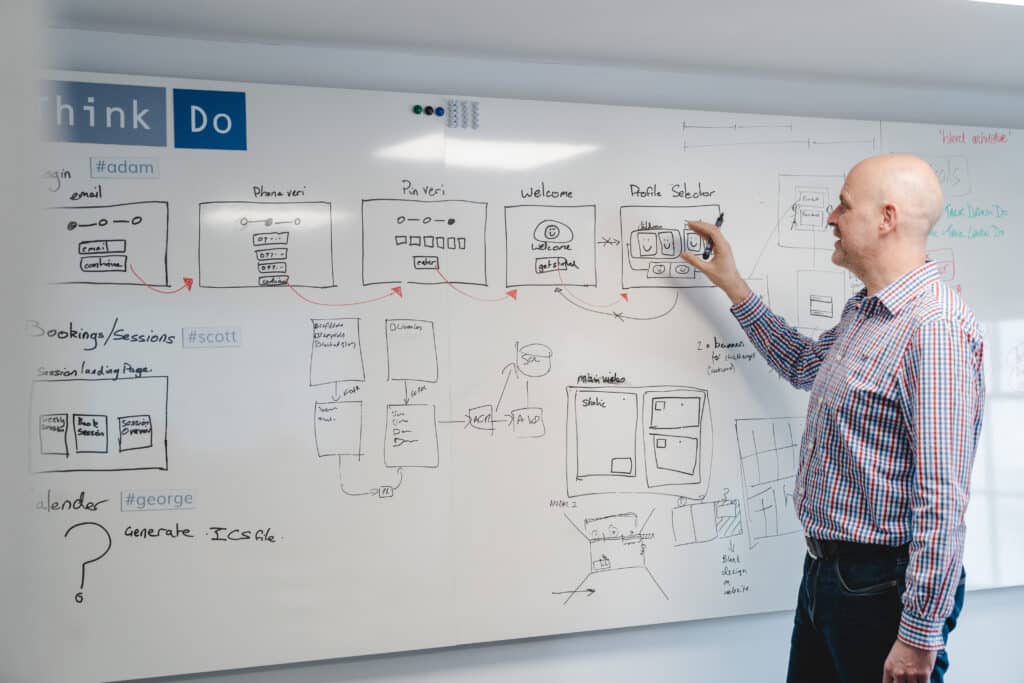Why Modernise Legacy Systems in the Cloud?

Few things move faster than the pace of technological change. Before you know it, an app that was once shiny and new is looking like it’s seen better days. Now it’s outdated, unwieldy and unfit for purpose.
At that point, it’s time to bring it up to date, and businesses are increasingly turning to the cloud to do that. Modernizing legacy applications is a strategic process that revitalizes outdated systems to enhance effectiveness and meet current standards. By leveraging the cloud, organizations can improve performance, security, and scalability, all of which are essential for supporting ongoing business growth and maintaining competitiveness. But just why are they moving to a new platform? Why modernise legacy systems in the cloud?
In this article, we’ll explore some of the key benefits of legacy application modernisation on cloud platforms like Microsoft Azure and Amazon Web Services (AWS). Let’s get started.
Introduction to Modernization
Legacy system modernization is the process of upgrading or replacing outdated legacy systems to align with contemporary business requirements and technological advances. This process is crucial for businesses to improve operational efficiency, enhance system performance, and integrate seamlessly with cloud solutions and emerging technologies. The demand for agility and real-time access to data makes modernization a necessity for businesses. Evaluating the business impact of legacy systems helps organizations prioritize which areas to modernize first, ensuring maximum benefit and value. Without legacy modernization, businesses risk losing out on operational improvements and innovations that can drive efficiency, enhance customer satisfaction, and improve overall market positioning. Legacy system modernization can mitigate operational risks and provide a competitive advantage in the fast-paced digital world.
Understanding Legacy Systems
Legacy systems are outdated technology and architecture that hinder an organization’s ability to keep up with changing business needs. These systems often take the form of monolithic systems, which are large, tightly-coupled applications that are difficult to modernize, and exhibit inefficient architecture, posing significant security and operational risks. Legacy systems can be characterized by slow response times, high maintenance costs, and limited compatibility with newer technologies. Legacy infrastructure, including outdated hardware and software, can further complicate modernization efforts by increasing complexity and reducing scalability. Understanding the limitations and challenges of legacy systems is essential for developing an effective modernization strategy. This involves assessing the current state of the system, identifying areas for improvement, and determining the best approach for modernization.
Drivers of Modernization
The drivers of modernization are diverse and can vary depending on the organization’s specific needs and goals. Cloud adoption is often a primary driver for legacy system modernization, as it plays a crucial role in improving application performance, enhancing security, and enabling future scalability. Common drivers include the need for enhanced security, improved performance, and increased business agility. Outdated technology can lead to security vulnerabilities, data breaches, and compliance issues, making modernization a critical step in ensuring the security and integrity of business operations. Additionally, modernization can help reduce technical debt, improve system performance, and increase business value. By adopting modern technologies and cloud-native platforms, businesses can improve operational efficiency, reduce costs, and enhance customer experience.
Cloud Technology and Modernisation
Cloud technology has become the backbone of legacy system modernization, providing businesses with a scalable, secure, and cost-effective foundation for their digital transformation journeys. By migrating existing systems to robust cloud platforms, organizations can significantly reduce operational costs while benefiting from advanced security measures that protect sensitive data and ensure compliance. Cloud infrastructure enables seamless integration with modern systems and supports the adoption of cloud-native platforms, which are designed to deliver improved performance and greater business agility.
Leveraging cloud technology also empowers businesses to adapt quickly to evolving business models and market demands. The flexibility of cloud platforms allows for rapid deployment of new features, easy data exchange with newer technologies, and the ability to scale resources up or down as needed. This adaptability is essential for organizations looking to future-proof their operations and stay competitive in a fast-changing landscape. Ultimately, cloud technology is not just a tool for modernization—it is a catalyst for innovation, enabling businesses to unlock new opportunities and drive sustained growth.
Hybrid Cloud Solutions
Hybrid cloud solutions offer a strategic pathway for organizations seeking to modernize legacy applications without sacrificing control or security. By blending the strengths of public and private clouds, businesses can migrate their legacy systems to a cloud environment while retaining sensitive workloads on-premises or in a private cloud. This approach ensures that critical business operations remain secure and compliant, even as outdated technology is phased out in favor of modern systems.
The flexibility of hybrid cloud allows companies to scale their infrastructure dynamically, optimizing system performance and resource utilization. As business needs change, hybrid cloud solutions make it easy to adjust capacity, ensuring a smooth transition from legacy applications to more agile, cloud-based environments. This minimizes disruptions and supports business continuity, enabling organizations to modernize at their own pace while maintaining operational stability. With hybrid cloud, businesses can confidently bridge the gap between legacy and modern systems, ensuring a seamless evolution of their IT landscape.
New business models and innovation
Digital transformation is moving the goalposts in your industry, altering competitors’ business models and customers’ expectations. You need to keep up or risk being left behind. Integrating new technologies is essential for revitalizing outdated systems and staying competitive. The cloud offers the kind of development agility and streamlined resource provisioning that allows you to match pace or even overtake them.
This ability to innovate means that technology can become a generator of value instead of a cost centre. It can become a vital asset that drives your future success instead of being a burden to be maintained.
Adopting modern solutions helps organizations reduce costs, improve user experience, and enables the adoption of cloud technology, making it easier to replace outdated systems and build a more efficient, scalable infrastructure.
A widely quoted statistic from Oracle’s Customer Experience Impact Report is that 86% of buyers will pay more for a better customer experience (CX). In 2020, much of that hinges on the digital CX you offer via customer-facing apps and other online services. If they don’t offer the ease of use and functionality your customers expect, they’ll happily jump ship to your competitors.
Scale and upgrade on demand by modernizing legacy systems
Want to increase your business agility? Cloud apps can be scaled up and down quicker and cheaper than monolithic on-premises variants. That’s because cloud apps are most often dealt with in terms of their individual components instead of as a whole, and can be deployed on various platforms, including public or hybrid cloud solutions.
This is known as ‘microservices architecture’. When software is built this way, an individual component can be scaled up if it’s subject to increased workload or performance demands. Services can be amped up, dialled down, added and removed according to your changing requirements. It’s a more agile and versatile way to deal with your technology needs.
Modernizing with cloud also enables organizations to upgrade or replace specific components incrementally, so there’s no need to overhaul the entire system at once.
The cloud allows you to align your resources, usage and costs more closely than ever before. As your business needs fluctuate, the ability to scale and make adjustments in this way is invaluable.
Optimise internal business processes
A bad user experience (UX) in your enterprise applications will hinder employees in just the same way as a clunky UX on a consumer-facing app will put off a customer. These tools are supposed to enable them to do their jobs more effectively and efficiently, and when help becomes hindrance, it’s time for change. Ensuring business continuity is crucial to maintaining seamless operations during unexpected failures, and modern systems enhance backup and disaster recovery options to minimize downtime.
People have become accustomed to the smooth, polished experiences of consumer-targeted mobile and desktop apps. When it comes to digital business tools, their expectations have risen accordingly, and the traditionally lagging world of enterprise apps is playing catch-up.
This includes bespoke or heavily customised solutions. Bringing your business applications up to date with consumer-grade UX might be a good reason why modernising legacy systems is in order.
Leveraging modern tools can streamline the modernization of enterprise applications, enabling phased rollouts and reducing downtime during transitions.
What’s more, today’s workforce demands flexibility, mobility, remote working and ‘bring your own device’ (BYOD). If you can’t offer that, maybe you should start thinking about legacy application modernisation. Establishing a common integration layer that facilitates new data exchange between modernized systems and legacy systems is essential to ensure seamless data synchronization during the migration process. You can be sure that your competitors are either considering it, implementing it, or are there already.
Security and Compliance
Security and compliance are critical considerations in legacy system modernization. Legacy systems often pose significant security risks, as they may no longer receive critical updates or patches. Modernized systems offer better security measures, including robust encryption, regular updates, and improved compliance with industry regulations. This reduces the likelihood of cyber threats and helps safeguard sensitive data. By integrating security measures into the modernization process, businesses can ensure that their systems are secure, compliant, and aligned with industry standards.
Cost Efficiency and Savings
Modernizing legacy systems delivers substantial cost efficiency and long-term savings for businesses. Transitioning to cloud infrastructure eliminates the need for expensive hardware upgrades and reduces ongoing maintenance costs associated with outdated systems. Modernized systems are designed for optimal system performance, which translates into lower operational expenses and improved productivity across the organization.
Cloud platforms often offer flexible, pay-as-you-go pricing models, allowing businesses to align their IT spending with actual usage and avoid unnecessary capital expenditures. Additionally, modernization efforts help reduce technical debt and security risks, further decreasing the likelihood of costly incidents or downtime. By investing in modern systems, companies not only achieve immediate cost efficiency but also position themselves for sustained growth and competitiveness in the marketplace.
Data Migration
Data migration is a critical aspect of legacy system modernization. Migrating large volumes of data from outdated systems to more modern platforms requires a high level of precision to ensure that data is not lost, corrupted, or inconsistently transferred. Ensuring data integrity is crucial for preventing disruptions in business operations. Syncing data between legacy and modernized systems during migration is essential to maintain data consistency and integrity, enabling seamless operation throughout the transition. Businesses should use automated migration tools, conduct data validation, and implement backup strategies to minimize risks. Running parallel systems for a transition period allows for verification before fully switching to the new system. Data cleansing and standardization should be performed before migration to prevent legacy data issues from carrying over. By adopting a phased approach to data migration, businesses can ensure a smooth transition and minimize downtime.
Business Continuity and Disaster Recovery
Ensuring business continuity and robust disaster recovery capabilities is a key benefit of legacy system modernization. By adopting modern systems and leveraging cloud technology, organizations can safeguard their business operations against unexpected disruptions, whether due to hardware failures, cyber incidents, or natural disasters. Cloud-based solutions provide automated backup and disaster recovery options, enabling rapid restoration of data and services with minimal downtime.
Modernized systems are often architected with redundancy and failover mechanisms, ensuring that critical business functions remain operational even in the face of adversity. This focus on data consistency and reliability means that businesses can maintain uninterrupted service delivery and protect their reputation. Ultimately, modernizing legacy systems is an investment in resilience, empowering organizations to navigate challenges and maintain business continuity in an increasingly unpredictable world.
Overcoming Challenges and Resistance
Successfully modernizing legacy systems requires overcoming a range of challenges and resistance within the organization. Common obstacles include technical debt, security concerns, and slow response times, all of which can hinder progress if not addressed proactively. Adopting a phased approach to modernization—breaking the process into manageable steps—can help mitigate risks and ensure a smooth transition to modern systems.
Effective change management is essential for a successful transformation. Investing in employee training and clear communication about the key benefits of modernization—such as enhanced security, improved performance, and cost efficiency—can help build support and reduce resistance. Prioritizing future proofing and ongoing maintenance ensures that modernized systems remain aligned with evolving business needs and continue to deliver value over time. By addressing concerns head-on and focusing on the long-term advantages, businesses can achieve a successful transformation and position themselves for future growth.
After ‘why’ comes ‘how’
These are all compelling reasons to move to the cloud, but once you’ve made your decision, there’s much still to consider. How are you going to get there?
The shape your refreshed applications will take should be determined by their function and your business needs – now and in the future. Will the migration be relatively simple and fast, a ‘lift and shift’? Will it require your apps to be completely rearchitected to bring them completely up to date and give you the edge you need? You should also consider various migration strategies, such as the ‘Strangler Pattern’ or the seven migration strategies, to ensure a smooth and efficient transition.
When modernizing legacy systems, organizations typically adopt common modernization strategies such as rehosting, replatforming, and rearchitecting. Each approach offers distinct features and benefits, from quick migrations to deeper redesigns that unlock cloud native capabilities for greater scalability and flexibility. It is essential to evaluate existing investments to maximize their value and ensure modernization aligns with business goals. Before selecting a strategy, assess the existing system’s capabilities and limitations to inform the best path forward. Maintaining legacy apps and legacy software often presents significant challenges, including technical debt and integration issues with modern solutions. Tracking key metrics throughout the modernization process helps measure progress and success. Integrating legacy systems with new systems can improve agility and operational efficiency, but overcoming significant challenges—such as minimizing operational disruptions—is crucial. Leveraging modern software development practices, like APIs and low-code platforms, can further accelerate legacy system modernization.
Talk Think Do can help you find out the best path. With many years of experience in legacy application modernisation, we’re skilled at quickly discovering exactly what an organisation’s business goals and requirements are, then shaping the solutions around them. After all, that’s the entire point of the exercise: making your rusty systems fit for purpose again. Sometimes, this might involve a complete system replacement, which, despite the significant initial investment, can lead to long-term savings and operational efficiencies.
Convinced yet? Or are you still wondering ‘Why modernise legacy systems in the cloud?’Get in touch with us today and let’s talk about where your business is now and where you need to take it in the future.
Get access to our monthly
roundup of news and insights
You can unsubscribe from these communications at any time. For more information on how to unsubscribe, our privacy practices, and how we are committed to protecting and respecting your privacy, please review our Privacy Policy.
See our Latest Insights
Working as One Team: How Our Business Analysts Bridge Vision and Delivery
When clients partner with us, they often expect engineers and designers. But one of the most powerful roles behind a successful digital product is often less visible: the Business Analyst (BA). At Talk Think Do, BAs aren’t just requirement-gatherers. We’re connectors, between vision and execution, users and features, partners and platforms. In the recent delivery…
Implementing RAG AI Search on On-Premise Files with our AI Search Accelerator
As demand for AI‑powered tools like Microsoft Copilot grows, many organisations are asking the same question: “How can we harness the power of generative AI without moving our sensitive data to the cloud?” In this guide, we’ll explain why Retrieval‑Augmented Generation (RAG) is so effective for on‑premise data and walk through a practical approach using…
Using AI to Strengthen ISO 27001 Compliance
Preparing for our ISO 27001:2022 recertification, and a transition from the 2013 standard, was no small task. As a custom software company handling sensitive client data, we hold ourselves to high standards around security and compliance. But this year, we approached the challenge differently. We built and deployed a custom AI Copilot agent to help…
Legacy systems are costing your business growth.
Get your free guide to adopting cloud software to drive business growth.




